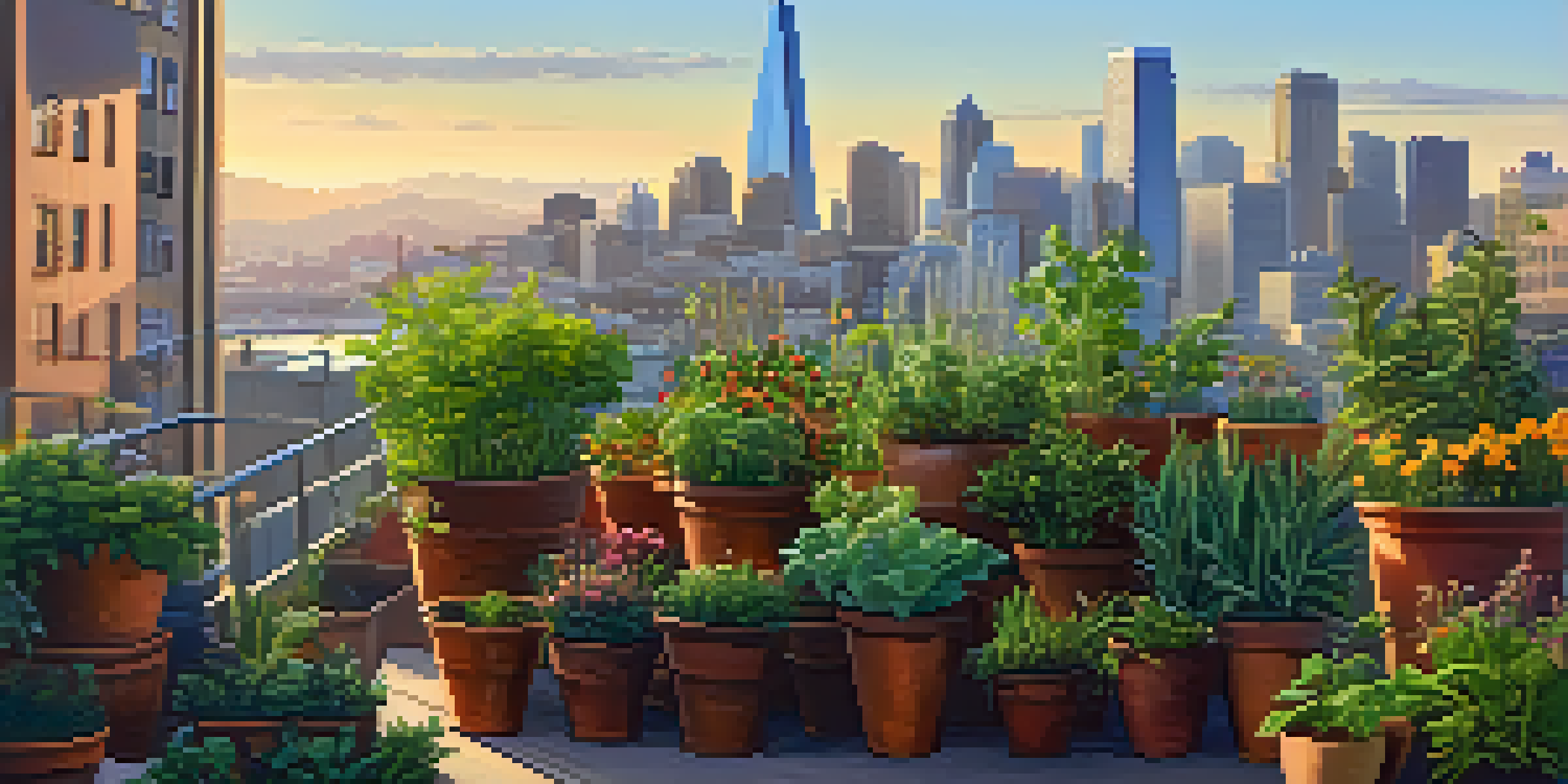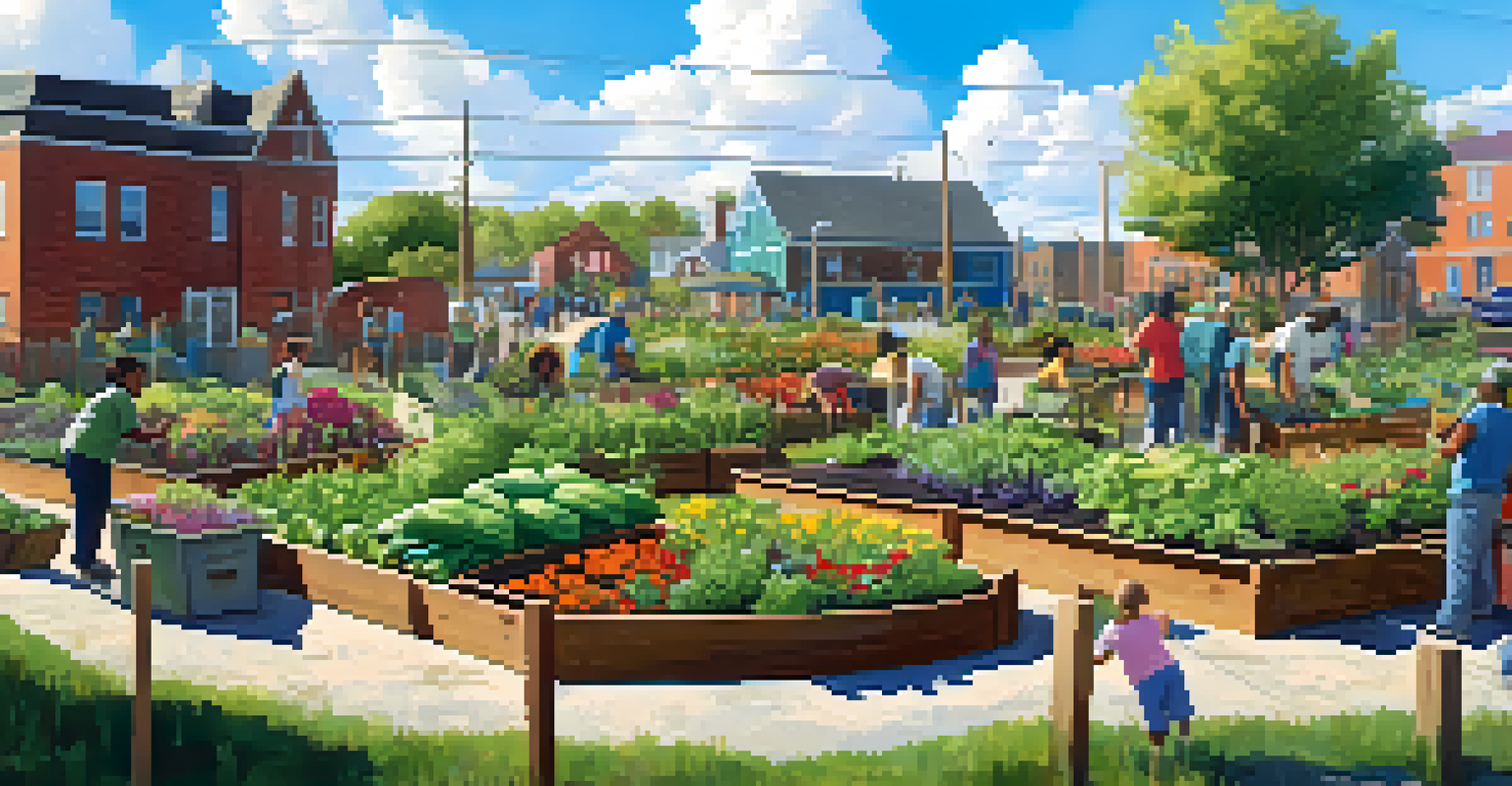Top Challenges Faced by San Francisco Urban Gardeners

Limited Space: The Urban Gardener's Dilemma
San Francisco is known for its vibrant urban landscape, but this often means limited space for gardening. Many residents find themselves with small backyards, balconies, or even rooftop gardens, which can make it challenging to cultivate a diverse array of plants. Gardeners must get creative, often utilizing vertical gardening techniques or container gardening to maximize their limited space.
Gardening is a way of showing that you believe in tomorrow.
This space constraint can lead to a lack of plant diversity, as certain plants require more area to thrive. For instance, a sprawling tomato plant might not fit comfortably in a small balcony setup. As a result, urban gardeners often have to prioritize which crops to grow, focusing on high-yield or compact varieties that suit their environment.
Moreover, sharing these small spaces with neighbors can lead to conflicts over aesthetics and maintenance. It's essential for urban gardeners to communicate and collaborate, turning these challenges into opportunities for community engagement and shared gardening experiences.
Soil Quality: The Hidden Challenge
One of the most significant yet overlooked challenges urban gardeners face is soil quality. In a city where much of the land has been developed, soil can be contaminated or simply insufficient for healthy plant growth. Urban gardeners must often test their soil and amend it with organic matter to ensure their plants have a solid foundation.

Contaminated soil can pose health risks, especially for those growing food crops. Heavy metals and other pollutants can leach into plants, making it critical for gardeners to understand their soil composition. Many turn to raised beds filled with quality soil as a solution, yet this can be a costly and labor-intensive endeavor.
Maximizing Limited Gardening Space
Urban gardeners often face space constraints, requiring creative solutions like vertical gardening and container planting to grow diverse crops.
Additionally, even when the soil is safe, it may not retain moisture well, leading to additional challenges in watering. Urban gardeners must be vigilant about soil health, often experimenting with various amendments and practices to create the best growing conditions possible.
Water Access: The Scarcity Issue
Access to water is another major hurdle for urban gardeners in San Francisco. With ongoing drought conditions in California, water conservation has become a priority, and gardeners are often left wondering how to keep their plants hydrated. Many need to adapt their watering practices, utilizing drip irrigation systems or rainwater collection methods to minimize waste.
To plant a garden is to believe in tomorrow.
In addition to conservation, the cost of water can add up quickly, especially for those maintaining larger gardens. Urban gardeners must be strategic about their watering schedules, often relying on early morning or late evening sessions to reduce evaporation. This can create a delicate balance between keeping plants healthy and managing resources wisely.
Moreover, some gardeners face restrictions on outdoor watering due to city regulations. This challenge prompts creative problem-solving, as urban gardeners explore drought-resistant plants or implement xeriscaping techniques to thrive in a water-scarce environment.
Pest Control: Navigating Urban Wildlife
Urban gardeners often find themselves in a battle against pests and wildlife. In a bustling city like San Francisco, common culprits like raccoons, squirrels, and various insects can wreak havoc on gardens. This challenge requires gardeners to be vigilant and proactive in their pest management strategies to protect their hard work.
Many urban gardeners prefer organic methods, using natural repellents or companion planting to deter pests without resorting to chemicals. However, this can be a tricky endeavor, as what works for one gardener may not be effective for another. Keeping a close eye on plant health and experimenting with different techniques is crucial for success.
Soil Quality is a Major Concern
Ensuring healthy soil is crucial, as urban gardeners must often amend contaminated or poor-quality soil to support their plants.
Additionally, community resources such as gardening clubs or local nurseries can provide support and advice for managing pests. By sharing experiences and solutions, urban gardeners can foster a sense of community while tackling this common challenge together.
Climate Adaptation: Embracing Local Weather Patterns
San Francisco's unique climate presents its own set of challenges for urban gardeners. The city's famous microclimates can lead to unpredictable weather, making it difficult to choose the right plants for specific locations. Gardeners must become adept at understanding local conditions, from foggy mornings to sunny afternoons, to ensure successful growth.
Choosing the right plants is essential, as some may thrive in cooler, shadier areas while others prefer full sun. This means gardeners need to research and experiment to discover which varieties will flourish in their specific environment. Understanding local weather patterns can significantly impact the gardening experience and overall yields.
Moreover, climate change adds another layer of complexity, with unpredictable weather patterns affecting traditional growing cycles. Urban gardeners must remain flexible, adapting their practices and plant choices to navigate these changes effectively.
Community Engagement: Building Support Networks
Urban gardening can sometimes feel isolating, especially for those new to the practice. However, building a community of like-minded gardeners can make all the difference in navigating the challenges of urban gardening. Local gardening groups, workshops, and community gardens provide essential support and foster connections among enthusiasts.
Networking with fellow gardeners can lead to sharing resources, tips, and even plant cuttings, creating a sense of camaraderie. This collaborative spirit not only enhances individual gardening experiences but also strengthens community bonds. Engaging with others can also help gardeners stay motivated and inspired.
Community Builds Gardening Success
Engaging with local gardening communities provides urban gardeners with essential support, resources, and camaraderie to overcome challenges.
In addition to gardening clubs, social media platforms have become valuable tools for urban gardeners to connect, share their successes, and seek advice. By leveraging these networks, urban gardeners can overcome common challenges while celebrating their achievements together.
Financial Constraints: Budgeting for Urban Gardening
Urban gardening can be an expensive endeavor, often requiring significant investment in soil, seeds, tools, and water. For many San Francisco residents, financial constraints can limit their gardening ambitions. Budgeting wisely becomes essential to ensure that gardeners can cultivate their green spaces without breaking the bank.
Many gardeners turn to DIY solutions to minimize costs, such as repurposing materials for planters or creating compost from kitchen scraps. These practices not only save money but also contribute to sustainable gardening efforts. By being resourceful, urban gardeners can create vibrant gardens without overspending.

Additionally, local programs and grants aimed at promoting urban gardening can offer financial assistance or resources. Exploring these opportunities can help alleviate some of the financial pressures and encourage more residents to embrace urban gardening.